Frigidaire FGMC3066UFA, FGMC3066UDA, FGMC3066UBA Owner’s Manual

All about the
Use&Care
of your Microwave / Wall Oven Combination
|
TABLE OF CONTENTS |
|
|
Product Record and Registration . . . . . . . |
. . . . . . . 2 |
Before Using Microwave Oven . . . . . . . . . . . . . . . |
37 |
Important Safety Instructions . . . . . . . . . . |
. . . . . . . 3 |
Setting the Microwave . . . . . . . . . . . . . . . . . . . . . . |
43 |
Cooking Recommendations . . . . . . . . . . . . |
. . . . . 12 |
Care and Cleaning . . . . . . . . . . . . . . . . . . . . . . . . |
50 |
Before Setting Oven Controls . . . . . . . . . . . |
. . . . . 15 |
Before You Call . . . . . . . . . . . . . . . . . . . . . . . . . . . |
56 |
Setting Oven Controls . . . . . . . . . . . . . . . . . |
. . . . . 17 |
Warranty . . . . . . . . . . . . . . . . . . . . . . . . . . . . . . . . |
59 |
2019) (January B Rev 807574502
www.frigidaire.com USA 1-800-944-9044 |
www.frigidaire.ca Canada 1-800-265-8352 |

PRODUCT RECORD AND REGISTRATION
Need Help? . . . . . . . . . . . . . . . . . . . . . . . . . . . . . . . . .2
Product Registration . . . . . . . . . . . . . . . . . . . . . . . . . .2
Product Record and Registration . . . . . . . . . . . . . . . . . 2
Important Safety Instructions . . . . . . . . . . . . . . . . . . . . 3
Cooking Recommendations . . . . . . . . . . . . . . . . . . . . 12
Before Setting Oven Controls . . . . . . . . . . . . . . . . . . 15
Setting Oven Controls . . . . . . . . . . . . . . . . . . . . . . . . . 17
Before Using Microwave Oven . . . . . . . . . . . . . . . . . . 37
Setting the Microwave . . . . . . . . . . . . . . . . . . . . . . . . . 43
Care and Cleaning . . . . . . . . . . . . . . . . . . . . . . . . . . . . 50
Before You Call. . . . . . . . . . . . . . . . . . . . . . . . . . . . . . . 56
Warranty . . . . . . . . . . . . . . . . . . . . . . . . . . . . . . . . . . . . 59
Questions?
For toll-free telephone support in the U.S. and Canada call
1-800-944-9044
For online support and product information visit http:// www.frigidaire.com.
Thank you for choosing Frigidaire.
This Use & Care manual is part of our commitment to customer satisfaction and product quality throughout the service life of your new appliance. We view your purchase as the beginning of a relationship. To ensure our ability to continue serving you, please use this page to record important product information.
Need Help?
Visit the Frigidaire web site at www.frigidaire.com
Before you call for service, there are a few things you can do to help us serve you better.
Read this Use & Care Manual
This manual contains instructions to help you use and maintain your oven properly.
If You Received a Damaged Oven...
Immediately contact the dealer (or builder) that sold you the oven.
Save Time and Money
Check “Solutions to Common Problems” on page 57. This section helps step you through some common problems that might occur.
If you do need service, help is only a phone call away. Call Frigidaire customer services at 1-800-944-9044.
Product Registration
Registering your product with Frigidaire enhances our ability to serve you. You can register online at http:// www.frigidaire.com or by dropping your product registration card in the mail.
Record model and serial numbers here
Purchase Date: _______________________________
Frigidaire model number: _______________________
Frigidaire serial number: ________________________
Serial Plate Location
2 |
|
|
|
|
|
2018 Electrolux Home Products, Inc. |
|
All rights reserved. Printed in the USA |
|||
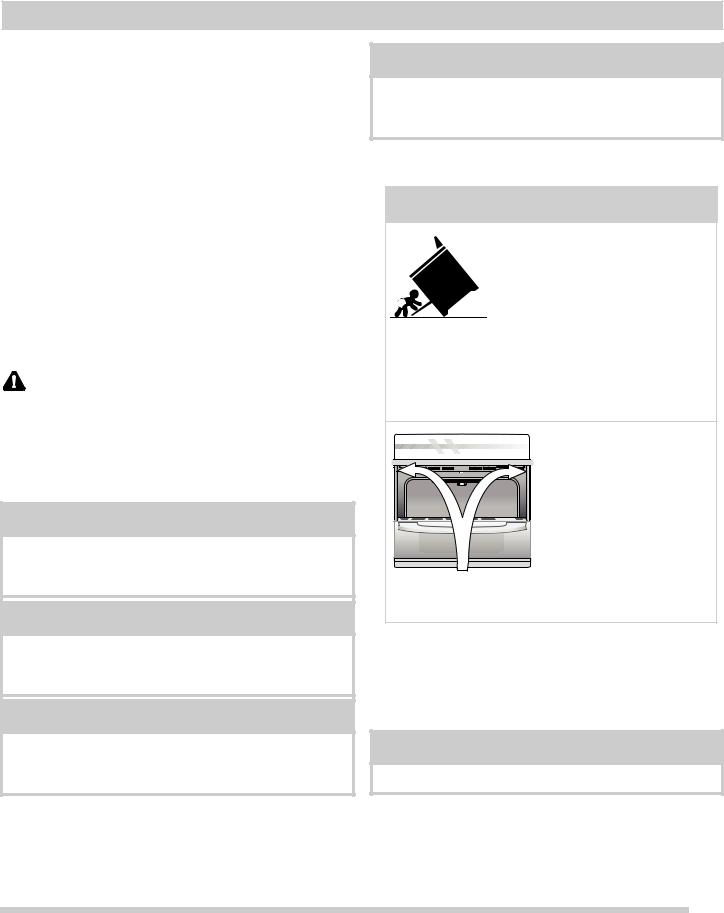
IMPORTANT SAFETY INSTRUCTIONS
Read all instructions before using this appliance.
This manual contains important safety symbols and instructions. Please pay attention to these symbols and follow all instructions given.
Do not attempt to install or operate your appliance until you have read the safety precautions in this manual. Safety items throughout this manual are labeled with a WARNING or CAUTION statement based on the risk type.
Warnings and important instructions appearing in this guide are not meant to cover all possible conditions and situations that may occur. Common sense, caution, and care must be exercised with installing, maintaining, or operating your appliance.
DEFINITIONS
This is the safety alert symbol. It is used to alert you to potential personal injury hazards. Obey all safety messages that follow this symbol to avoid possible injury or death.
 WARNING
WARNING
Indicates a potentially hazardous situation which, if not avoided, may result in death or serious injury.
 CAUTION
CAUTION
Indicates a potentially hazardous situation which, if not avoided, may result in minor or moderate injury.
 NOTE
NOTE
Indicates a short, informal reference-something written down to assist the memory or for future reference.
 WARNING
WARNING
Tip Over Hazard
•A child or adult can tip the oven and be killed.
•Install the anti-tip device to
oven and/or structure per installation instructions.
•Ensure the anti-tip device is re-engaged when the oven is moved.
•Do not operate the oven without the anti-tip device in place and engaged.
•Failure to follow these instructions can result in death or serious burns to children and adults.
|
Refer to the installation |
|
instructions supplied with your |
|
appliance for proper installa- |
|
tion. |
|
Check for proper installation |
|
with a visual check that the |
|
anti-tip screws are present. |
|
Test the installation with light |
Anti-tip mounting holes |
downward pressure on the |
|
open oven door. The oven |
should not tip forward.
 IMPORTANT
IMPORTANT
Indicates installation, operation, maintenance, or valuable information that is not hazard related.
 IMPORTANT
IMPORTANT
Save these instructions for future reference.
3

IMPORTANT SAFETY INSTRUCTIONS
PRECAUTIONS TO AVOID POSSIBLE EXPOSURE TO EXCESSIVE MICROWAVE ENERGY
For your safety, the information in this manual must be followed to minimize the risk of fire or explosion or to prevent property damage, personal injury or loss of life. Adhere to the following precautions:
•DO NOT attempt to operate the microwave oven with the door open since open-door operation can result in harmful exposure to microwave energy. It is important not to defeat or tamper with the safety interlocks.
•DO NOT place any object between the microwave oven front face and the door or allow soil or cleaner residue to accumulate on sealing surfaces.
•DO NOT operate the microwave oven if it is damaged. It is particularly important that the oven door close properly and that there is no damage to the: (1) door (bent), (2) hinges and latches (broken or loosened), (3) door seals and sealing surfaces.
•The microwave oven should not be adjusted or repaired by anyone except properly qualified service personnel.
IMPORTANT INSTRUCTIONS FOR
UNPACKING AND INSTALLATION
 IMPORTANT
IMPORTANT
Read and follow the below instructions and precautions for unpacking, installing, and servicing your appliance:
Remove all tape and packaging before using the appliance. Destroy the carton and plastic bags after unpacking the appliance. Never allow children to play with packaging material. Do not remove the wiring label and other literature attached to the range. Do not remove model/ serial number plate.
Cold temperatures can damage the electronic control. When using this appliance for the first time, or when the appliance has not been used for an extended period of time, be sure the appliance has been in temperatures above 32ºF
(0ºC) for at least 3 hours before turning on the power to the appliance.
Never modify or alter the construction of the appliance by removing the leveling legs, panels, wire covers, anti-tip brackets/screws, or any other part of the appliance.
Be sure to have an appropriate foam-type fire extinguisher available, visible, and easily accessible located near the appliance.
GROUNDING INSTRUCTIONS
 WARNING
WARNING
Avoid fire hazard or electrical shock. Failure to follow this warning may cause serious injury, fire, or death.
Avoid fire hazard or electrical shock. Do not use an adapter plug, use an extension cord, or remove grounding prong from the power cord. Failure to follow this warning may cause serious injury, fire, or death.
Proper Installation—Be sure your appliance is properly installed and grounded by a qualified technician. In the United States, install in accordance with the National Fuel Gas Code ANSI Z223.1/NPFA No. 54, latest edition and National Electrical Code NFPA No. 70 latest edition, and local electrical code requirements. In Canada, install in accordance with CAN/CGA B149.1 and CAN/CGA B149.2 and CSA Standard C22.1,
Canadian Electrical code, Part 1-latest editions and local electrical code requirements. Install only per installation instructions provided in the literature package for this appliance.
Save these instructions for future reference
4

IMPORTANT SAFETY INSTRUCTIONS
For personal safety, this appliance must be properly grounded. For maximum safety, the power cord must be securely connected to an electrical outlet or junction box that is the correct voltage, is correctly polarized and properly grounded, and protected by a circuit breaker in accordance with local codes.
It is the personal responsibility of the consumer to have the appropriate outlet or junction box with the correct, properly grounded wall receptacle installed by a qualified electrician. It is the responsibility and obligation of the consumer to contact a qualified installer to assure that the electrical installation is adequate and is in conformance with all local codes and ordinances.
See the installation instructions packaged with this appliance for complete installation and grounding instructions.
IMPORTANT INSTRUCTIONS FOR USING THE APPLIANCE
 WARNING
WARNING
Storage In or On Appliance—Flammable materials should not be stored in an oven, near surface burners, or in the warmer drawer (if equipped). This includes paper, plastic, and cloth items, such as cookbooks, plastic ware, and towels, as well as flammable liquids. Do not store explosives, such as aerosol cans, on or near the range.
Do not leave children alone - Children should not be left alone or unattended in the area where the appliance is in use. They should never be allowed to sit or stand on any part of the appliance, including the storage drawer, lower broiler drawer, or lower double oven.
Do not store items of interest to children in the cabinets above the range. Children climbing on the range to reach items could be seriously injured.
 WARNING
WARNING
Do not allow children to climb or play around the appliance. The weight of a child on an open oven door may cause the appliance to tip, resulting in serious burns or other injury. An open drawer when hot may cause burns.
Stepping, leaning, or sitting on the door or drawers of this appliance can result in serious injuries and also cause damage to the appliance.
Never cover any slots, holes, or passages in the oven bottom or cover an entire oven rack with materials such as aluminum foil or aftermarket oven liners. Doing so blocks air flow through the oven and may result in carbon monoxide poisoning. Aluminum foil linings may trap heat, causing a fire hazard.
Do not use oven or warmer drawer (if equipped) for storage.
Never use your appliance as a space heater to heat or warm the room. Doing so may result in carbon monoxide poisoning and overheating of the appliance.
 CAUTION
CAUTION
When heating fat or grease, watch it closely.
Grease may catch fire if it becomes too hot.
Do not use water or flour on grease fires. Smother fire or flame or use dry chemical or foam-type extinguisher. Cover the fire with a pan lid or use baking soda.
Use dry potholders. Moist or damp potholders on hot surfaces may result in burns from steam.
Do not let potholders touch hot cooking areas.
Do not use towels or other bulky cloths.
Save these instructions for future reference
5

IMPORTANT SAFETY INSTRUCTIONS
 CAUTION
CAUTION
Do not heat unopened food containers - Buildup of pressure may cause container to burst and result in injury.
Wear proper apparel - Loose-fitting or hanging garments should never be worn while using the appliance. Do not let clothing or other flammable materials contact hot surfaces.
Do not touch surface burners or elements, areas near these burners or elements, interior surfaces of the oven, or the warmer drawer (if equipped). Surface burners and elements may be hot even though they appear cool. Areas near surface burners and elements may become hot enough to cause burns. During and after use, do not touch, or let clothing or other flammable materials touch these areas until they are cool. These areas may include the cooktop, surfaces facing the cooktop, oven vent areas, oven door, and oven window.
Do not attempt to operate the appliance during a power failure. If the power fails, always turn off the appliance. If the appliance is not turned off and the power resumes, electric surface elements may resume operation when power is restored. Once the power resumes, reset the clock and the oven function.
IMPORTANT INSTRUCTIONS FOR USING YOUR OVEN
Protective liners—Do not use aluminum foil, aftermarket oven liners, or any other materials or devices to line oven bottom, oven racks, or any other part of the appliance. Only use aluminum as recommended for baking, such as lining cookware or as a cover placed on food. Any other use of protective liners or aluminum foil may result in a risk of electric shock or fire or a short circuit.
Use care when opening oven door, lower oven door, or warmer drawer (some models). Stand to the side of the appliance when opening the door of a hot oven. Let hot air or steam escape before you remove or replace food in the oven.
Keep oven vent ducts unobstructed. Touching surfaces in this area when the oven is on may cause severe burns. Do not place plastic or heatsensitive items on or near the oven vent. These items can melt or ignite.
Placement of oven racks - Always place oven racks in desired location while oven is cool. If rack must be moved while oven is hot, do not let potholder contact hot burner or element in oven. Use potholders and grasp the rack with both hands to reposition. Remove all cookware and utensils before moving the rack.
Do not use a broiler pan without its insert. Broiler pans and inserts allow dripping fat to drain away from the high heat of the broiler. Do not cover the broiler insert with aluminum foil; exposed fat and grease could ignite.
Do not cook food on the oven bottom. Always cook in proper cookware and always use the oven racks.
Save these instructions for future reference
6

IMPORTANT SAFETY INSTRUCTIONS
IMPORTANT INSTRUCTIONS FOR USING YOUR MICROWAVE OVEN
 WARNING
WARNING
When using electrical appliances, basic safety precautions should be followed to reduce the risk of burns, electric shock, fire, injury to persons, or exposure to excessive microwave energy.
Read all instructions before using the appliance.
Read and follow the specific PRECAUTIONS TO AVOID POSSIBLE EXPOSURE TO EXCESSIVE MICROWAVE ENERGY.
Install or locate this appliance only in accordance with the provided installation instructions.
Some products such as whole eggs and sealed containers - for example, closed jars - are able to explode and should not be heated in this microwave oven.
Use this appliance only for its intended use as described in this manual. Do not use corrosive chemicals or vapors in this appliance. This type of microwave oven is specifically designed to heat, cook, or dry food. It is not designed for industrial or laboratory use.
As with any appliance, close supervision is necessary when used by children or infirm persons.
 WARNING
WARNING
This appliance, including power cord, must be serviced only by qualified service personnel.
Contact nearest authorized servicer for examination, repair, or adjustment.
Do not cover or block any vents or openings on the microwave oven.
Do not store or use this appliance outdoors.
Do not use this product near water - for example: near a kitchen sink, in a wet basement, near a swimming pool, or similar locations.
Oversized foods or oversized metal utensils should not be inserted in a microwave oven as they may create a fire or risk of electric shock.
Do not clean with metal scouring pads. Pieces can burn off the pad and touch electrical parts, involving a risk of electric shock.
Do not use paper products when appliance is operated in the convection or mix mode (some models).
Do not cover racks (if equipped) or any other part of the microwave oven with metal foil. This will cause overheating of the microwave oven.
Review the door cleaning instructions in the operating instructions.
Save these instructions for future reference
7

IMPORTANT SAFETY INSTRUCTIONS
 CAUTION
CAUTION
To reduce the risk of fire in the microwave oven cavity, take the following precautions:
Do not overcook food. Carefully attend to the appliance when paper, plastic or other combustible materials are placed inside the microwave oven to facilitate cooking.
Remove wire twist-ties from paper or plastic bags before placing bags in the microwave oven.
If materials inside the microwave oven ignite, keep oven door closed, turn oven off, and disconnect the power cord or shut off power at the fuse or circuit breaker panel.
Do not use microwave oven cavity for storage purposes.
Do not leave paper products, cooking utensils, or food in the cavity when not in use.
Liquids such as water, coffee, or tea are able to be overheated beyond the boiling point without appearing to be boiling. Visible bubbling or boiling when the container is removed from the microwave oven is not always present. This could result in very hot liquids suddenly boiling over when a spoon or other utensil is inserted into the liquid.
 CAUTION
CAUTION
To reduce the risk of injury to persons from boiling liquids:
Do not overheat the liquid.
Stir the liquid both before and halfway through heating it.
Do not use straight-sided containers with narrow necks. Use wide-mouthed containers.
After heating, allow the container to stand in the microwave oven at least 20 seconds before removing.
Use extreme care when inserting spoons or other utensils into the container.
If the microwave oven light fails, consult an authorized servicer.
Save these instructions for future reference
8

IMPORTANT SAFETY INSTRUCTIONS
 CAUTION
CAUTION
Before manually cleaning any part of the appliance, be sure all controls are turned off and the range is cool. Cleaning a hot oven can cause burns.
Do not overcook food. Carefully attend to the appliance when paper, plastic or other combustible materials are placed inside the microwave oven to facilitate cooking.
Remove wire twist-ties from paper or plastic bags before placing bags in the microwave oven.
If materials inside the microwave oven ignite, keep oven door closed, turn oven off, and disconnect the power cord or shut off power at the fuse or circuit breaker panel.
Do not use microwave oven cavity for storage purposes.
Do not leave paper products, cooking utensils, or food in the cavity when not in use.
Liquids such as water, coffee, or tea are able to be overheated beyond the boiling point without appearing to be boiling. Visible bubbling or boiling when the container is removed from the microwave oven is not always present. This could result in very hot liquids suddenly boiling over when a spoon or other utensil is inserted into the liquid.
To reduce the risk of injury to persons from boiling liquids:
Do not overheat the liquid.
Stir the liquid both before and halfway through heating it.
 CAUTION
CAUTION
Do not use straight-sided containers with narrow necks. Use wide-mouthed containers.
After heating, allow the container to stand in the microwave oven at least 20 seconds before removing.
Use extreme care when inserting spoons or other utensils into the container.
If the microwave oven light fails, consult an authorized servicer.
IMPORTANT INSTRUCTIONS FOR CLEANING YOUR APPLIANCE
 CAUTION
CAUTION
Before manually cleaning any part of the appliance, be sure all controls are turned off and the range is cool. Cleaning a hot oven can cause burns.
Clean the appliance regularly to keep all parts free of grease that could catch fire. Do not allow grease to accumulate. Greasy deposits in the fan could catch fire.
Always follow the manufacturer’s recommended directions for use of kitchen cleaners and aerosols. Be aware that excess residue from cleaners and aerosols may ignite causing damage and injury.
Clean ventilating hoods frequently - Grease should not be allowed to accumulate on hood or filter. Follow the manufacturer’s instructions for cleaning vent hoods.
Save these instructions for future reference
9

IMPORTANT SAFETY INSTRUCTIONS
IMPORTANT INSTRUCTIONS FOR SELF CLEANING OVENS
Do not clean the oven door gasket. The door gasket is essential for a good seal. Care should be taken not to rub, damage, or move the gasket.
Do not use oven cleaners. No commercial oven cleaner or oven liner protective coating of any kind should be used in or around any part of the appliance.
Use the self clean cycle to clean only the parts listed in this manual.
Before using self clean, remove the broiler pan, any food, utensils, and cookware from the oven, storage drawer or warming drawer (if equipped). Remove oven racks unless otherwise instructed.
Some birds are extremely sensitive to the fumes given off during the self clean cycle of any oven. Move birds to another well-ventilated room.
IMPORTANT INSTRUCTIONS FOR SERVICE AND MAINTENANCE
Do not repair or replace any part of the appliance unless specifically recommended in the manuals. All other servicing should be done only by a qualified technician. This reduces the risk of personal injury and damage to the appliance.
Always contact your dealer, distributor, service agent, or manufacturer about problems or conditions you do not understand.
Ask your dealer to recommend a qualified technician and an authorized repair service. Know how to disconnect the power to the appliance at the circuit breaker or fuse box in case of emergency.
Remove the oven door from any unused oven if it is to be stored or discarded.
Do not touch a hot oven light bulb with a damp cloth. Doing so could cause the bulb to break. Handle halogen lights (if equipped) with paper towels or soft gloves. Disconnect the appliance or shut off the power to the appliance before removing and replacing the bulb.
Save these instructions for future reference
10

IMPORTANT SAFETY INSTRUCTIONS
 WARNING
WARNING
California Residents: for cancer and reproductive harm information, visit www.P65Warnings.ca.gov
Federal Communications Commission Radio Frequency Interference Statement (USA only)
This equipment generates and used ISM frequency energy and if not installed and used properly, that is in strict accordance with the manufacturer's instructions, may cause interference to radio and television reception. It has been type tested and found to comply with limits for
ISM Equipment pursuant to part 18 of FCC Rules, which are designed to provide reasonable protection against such interference in a residential installation.
However, there is no guarantee that interference will not occur in a particular installation. If this equipment does cause interference to radio or television reception, which can be determined by turning the equipment on and off, the user is encouraged to try to correct the interference by one or more of the following:
•Reorient the receiving antenna of the radio or television.
•Relocate the microwave oven with respect to the receiver.
•Move the microwave oven away from the receiver.
•Plug the microwave oven into a different outlet so that the microwave oven and the receiver are on different branch circuits.
The manufacturer is not responsible for any radio or television interference cause by unauthorized modification to this microwave oven. It is the responsibility of the user to correct such interference.
Save these instructions for future reference
11
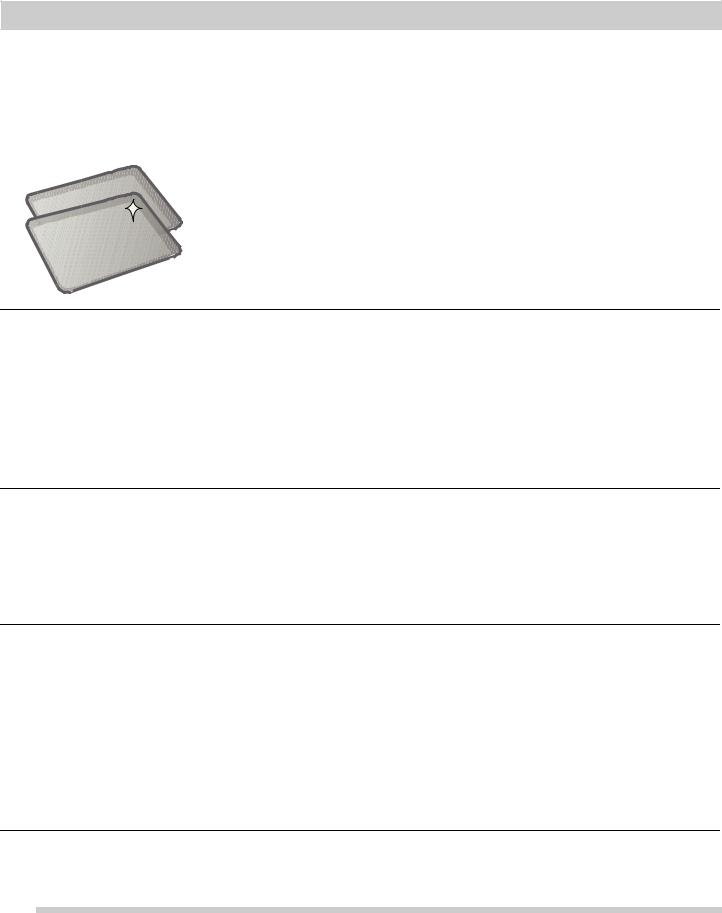
COOKING RECOMMENDATIONS
Bakeware
The material of bakeware affects how evenly and quickly it transfers heat from the pan to the food.
Material |
Attributes |
Recommendation |
|
|
|
Shiny metal bakeware |
Shiny, aluminum, and non-coated |
Recommended cooking temperatures and |
|
bakeware is the best for even heating. |
times are based on shiny metal bakeware. |
|
It is suitable for all baked goods. |
|
Dark metal bakeware |
Dark bakeware cooks hotter than shiny |
|
bakeware. |
Reduce the cooking temperature by 25° F (13-14° C) when using dark bakeware.
Glass bakeware |
Glass bakeware cooks hotter than |
|
shiny bakeware. |
|
Glass is convenient, as the same piece |
|
of bakeware can be used for cooking, |
|
serving, and storing food. |
Reduce the cooking temperature by 25° F (13-14° C) when using glass bakeware.
Insulated bakeware |
Insulated bakeware cooks cooler than |
|
shiny bakeware. |
|
Insulated bakeware is designed for |
|
baking in gas ovens. |
Increase the cooking temperature by 25° F (13-14° C) when using insulated bakeware.
12
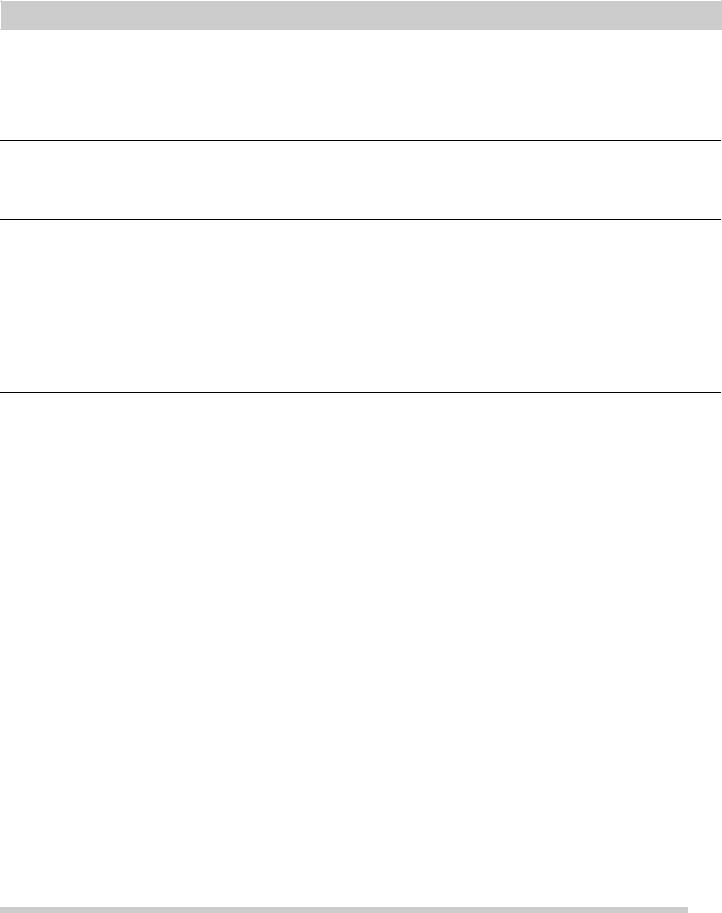
COOKING RECOMMENDATIONS
Cooking Conditions
Conditions in your kitchen can affect the performance of your appliance when cooking food.
Condition |
Attributes |
Recommendation |
Aging cookware |
As pans age and become discolored, |
|
cooking times may need to be reduced |
|
slightly. |
If food is too dark or overcooked, use the minimum cook time in the recipe or packaging.
If food is too light or undercooked, use the middle to maximum cook time in the recipe or packaging.
High altitude |
Air is drier and air pressure is lower. |
|
Water boils at a lower temperature, and |
|
liquids evaporate faster. |
|
Foods may take longer to bake. |
|
Doughs may rise faster. |
Adjust cooking temperature, cooking time, or recipes as needed.
Increase amount of liquid in baking recipes.
Increase cook time on cooktop. Cover dishes to reduce evaporation.
Increase bake time or oven temperature.
Reduce amount of baking soda or baking powder in recipe. Reduce rising time or punch down dough and allow it to rise twice.
Cooking Results
Small adjustments may fix a problem with food not being as done as you like or more done than you like.
Result |
Recommendation |
|
|
Food too light |
Use the middle to maximum cook time recommended on packaging or recipe. |
|
|
Food too dark |
Use the minimum cook time recommended on packaging or recipe. |
|
|
Cooking Tips
Use these additional tips to get the best results from your appliance.
Cooking |
Tips |
|
|
|
Baking |
|
|
Rack placement |
Follow the instructions in “Oven Control Features” on starting on page 17. |
|
When using only one rack, place the rack so the food is in the center of the oven. |
|
|
Preheat |
Fully preheat the oven before baking items like cookies, cakes, biscuits and breads. Insert food |
|
immediately after the beep. |
|
|
Checking food |
Use the window and oven light when checking food. Opening the door may reduce baking perfor- |
|
mance. |
|
|
Bake or Convec- |
Convection bake is the best function to use for baking on multiple racks. For best performance, see |
tion Bake |
“Convection Bake” on page 22. |
|
|
13

COOKING RECOMMENDATIONS
Cooking |
Tips |
|
|
Food placement |
Allow at least 2 inches (5 cm) of space between bakeware for proper air circulation. |
|
|
|
Broiling / Roasting |
|
|
Broiling pan |
For best results when broiling, use a broil pan with a broil pan insert designed to drain the fat from |
|
the food, help avoid spatter, and reduce smoking. The broiler pan will catch grease spills, and the |
|
insert helps prevent grease splatters. |
|
If a broiler pan and insert are not supplied with this appliance, they may be purchased from Frigid- |
|
aire.com. |
|
|
|
Convection Cooking |
|
|
Convection |
Convection cooking uses a fan to circulate hot air around the oven and food. It browns food more |
attributes |
evenly and reduces hot spots in the oven. |
|
Convection saves time when using multiple racks or cooking several food items at once. |
|
|
Convection bake |
Reduce cooking temperature by 25° F (13-14° C) from the recipe unless the recipe is written for |
|
convection baking. |
|
Preheat the oven for best results. |
|
|
Convection roast |
Convection roast is best for meats and does not require preheating for most meats and poultry. |
|
Reducing the cooking temperature for convection roast is not recommended. Carefully follow your |
|
recipe’s temperature and time recommendations, adjusting the cooking time if the recipe does not |
|
specify convection roasting time. |
|
Since convection roast cooks faster, cook time may be reduced by 25% to 40% depending on food |
|
type. You can reduce cook times by 25% from the recommended time of your recipe, and check the |
|
food at this time. If needed, continue cooking until the desired doneness is obtained. |
|
Use a meat probe if available with your appliance. Meat probes are also available from most grocery |
|
and home goods stores. |
|
Arrange oven racks so large cuts of meat and poultry are on the lowest rack of the oven. |
|
Do not cover foods when dry roasting - covering will prevent the meat from browning properly. |
|
When cooking meats, use the broiler pan and insert or a roasting rack. The broiler pan will catch |
|
grease spills and the insert helps prevent grease splatters. If you do not have one of these accesso- |
|
ries, they may be purchased from Frigidaire.com. |
|
|
14
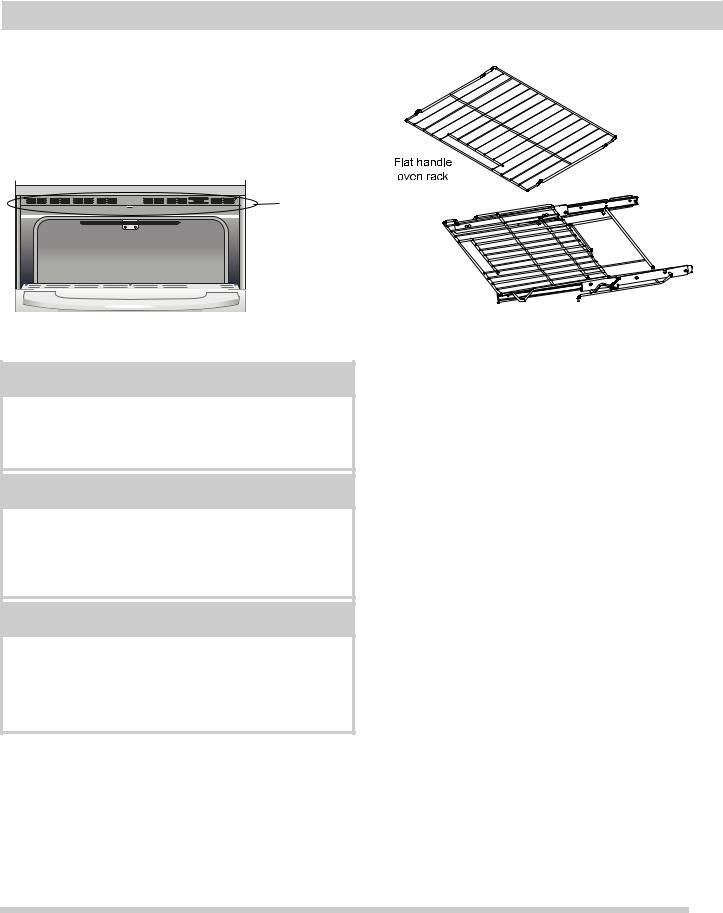
BEFORE SETTING OVEN CONTROLS
Oven Vent Location
The oven is vented as shown below. When the oven is on, warm air is released through the vent. This venting is necessary for proper air circulation in the oven and good baking results. Do not block oven vent. Never close off the openings with aluminium foil or any other material. Steam or moisture may appear near the oven vent; this is normal.
|
oven vent |
|
location |
Figure 1: |
Do not block oven vent location |
 CAUTION
CAUTION
Always use pot holders or oven mitts when using the oven. When cooking, the oven interior and exterior, oven racks, and cooktop will become very hot which can cause burns.
 WARNING
WARNING
Protective Liners — Do not use aluminum foil or any other materials to line the oven bottom, walls, racks or any part of the oven. Only use aluminum foil as recommended in this manual. Improper installation of these liners may result in risk of electric shock or fire.
 IMPORTANT
IMPORTANT
All oven racks should be removed before a self clean operation. Racks left in the oven during the high heat of the self clean function can easily discolor.
The ability of the racks to easily slide in and out along the rack positions may also be affected.
Types of oven racks
glide rack
Figure 2: Oven rack types
•Flat oven racks may be used for most cooking needs and may be placed in most oven rack positions.
•The fully extendable glide rack makes food preparation easier. This oven rack has glide tracks that allow the rack to be pulled away from the oven without rubbing the sides of the oven wall.
Removing, replacing, and arranging flat or offset oven racks
To arrange - Always arrange the oven racks when the oven is cool (prior to operating the oven).
To remove - Pull the oven rack straight forward until it reaches the stop position. Lift up front of oven rack slightly and slide out.
To replace - Place the oven rack on the rack guides on both sides of oven walls. Tilt the front of oven rack upward slightly and slide the oven rack back into place. Be sure oven racks are level before using.
15
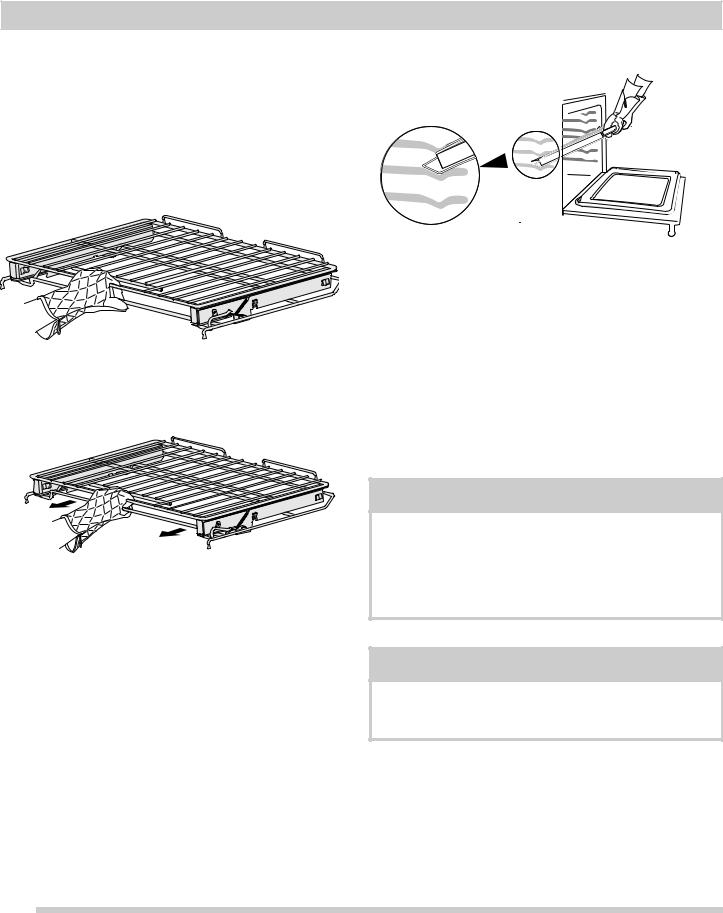
BEFORE SETTING OVEN CONTROLS
Removing and Replacing the Glide Racks
The fully extendable Glide rack makes food preparation easier. This oven rack has glide tracks that allow the rack to be pulled away from the oven without rubbing the sides of the oven wall.
To remove - Make sure the baking rack is in the closed position. Using one hand, reach through handle opening and grasp both the upper and lower portions of the glide rack as shown in Figure 3.
Figure 3: Grasp both rack sections
While holding both sections, pull the glide rack out of the oven until the stop position is reached (Figure 4).
Figure 5: Remove and replace using both hands
The rack portions move independently and are difficult to handle unless held together.
To replace - Make sure the baking rack is in the closed position. Grasp both upper and lower portions of glide rack. Lift and hold the rack level between the oven cavity walls. Tilt the front of the rack upward slightly and slide the rack completely into position.
Important: To prevent possible damage to the oven, do not attempt to close the oven door until all the oven racks are fully positioned back inside the oven cavity.
Figure 4: Pull rack to stop position
Using both hands, lift up the front of the rack slightly and continue to pull the rack away from the oven (Figure 5). Be sure to grasp both upper and lower rack portions together when removing or handling the glide rack.
 IMPORTANT
IMPORTANT
Do not line the oven walls, racks, bottom or any other parts of the oven with aluminum foil or with any other materials or oven liners. Doing so will alter heat distribution and may cause permanent damage to the oven interior. During clean the oven temperatures will be hot enough to melt foil.
 CAUTION
CAUTION
Remove all oven racks and clean according to instructions provided in the Care & Cleaning section of this manual. Never pick up hot oven racks or parts.
16

SETTING OVEN CONTROLS
1 |
2 |
3 |
4 |
|
|
|
13 |
14 |
15 |
|
|
|
|
|
|
12 |
|
|
|
5 |
6 |
7 |
8 |
|
|
|
|
17 |
18 |
|
|
|
|
|
16 |
|
|
||
|
|
|
|
9 |
19 |
|
|
|
|
|
|
|
|
|
|
|
|||
|
|
|
10 |
20 |
|
|
|
||
|
|
|
|
|
11 |
|
|
|
|
|
|
|
|
|
|
|
|
|
|
Oven Control Features
1.Bake - Use to enter normal baking temperatures for recipes that call for regular baking.
2.Broil - Selects normal broil function for direct heat cooking.
3.Quick Preheat - Best used for single rack baking with packaged, convenience, and made from scratch foods.
4.Warm - Use to keep cooked foods at serving temperature.
5.Conv Bake - Circulates the oven heat evenly and continuously for baking foods.
6.Conv Roast - Uses a convection fan to gently brown meats and poultry and seal in the juices.
7.Convect Convert - Converts standard bake temperatures to convection temperature in convection bake feature.
8.Bread Proof - Maintains a warm environment useful for rising of yeast-leavened products.
9.Timer on-off - Use to set or cancel the minute timer. The minute timer does not start or stop any cooking function.
10.Add A Min - Use to add additional minutes to the timer.
11.0 through 9 keys - Use to set temperature and set clock.
12.OK/START - Use to start cooking functions and when setting the clock.
13.Oven Light - Use to turn on internal light. Will turn on when the oven door is open.
14.Delay Start - Add to any cooking function and Self Clean to program a delayed starting time.
15.Meat Probe - Use when cooking meat like roasts, hams or poultry to cook to the desired internal temperature without any guesswork.
16.OFF - Use to turn off all cooking functions.
17.Self Clean - Use to set self-clean cycle between 2 and 4hrs.
18.Steam Clean - Use as a time saving method for cleaning light soils.
19.Set Clock - Use set the time of day
20.Oven Lock - Use to lock out oven controls.
Feature |
Mode |
Min.Temp. / |
Max Temp. |
|
|
Time |
/Time |
|
|
|
|
Quick Preheat |
|
170°F (77°C) |
550°F (288°C) |
|
|
|
|
Bake |
|
170°F (77°C) |
550°F (288°C) |
|
|
|
|
Broil |
|
400°F (205°C) |
550°F (288°C) |
|
|
|
|
Conv Bake |
|
170°F (77°C) |
550°F (288°C) |
|
|
|
|
Conv Roast |
|
170°F (77°C) |
550°F (288°C) |
|
|
|
|
Meat Probe |
|
140°F (60°C) |
210°F (99°C) |
|
|
|
|
Warm |
|
170°F (77°C) |
until canceled |
|
|
|
|
Bread Proof |
|
100°F (38°C) |
until canceled |
|
|
|
|
Timer |
|
0:01 Min. |
11:59 Hr./Min. |
|
|
|
|
Clock Time |
12 Hr. |
1:00 Hr./Min. |
12:59 Hr./Min. |
|
24 Hr. |
0:00 Min |
23:59 Hr./Min. |
|
|
|
|
Delay Start |
12 Hr. |
1:00 Hr./Min. |
12:59 Hr./Min. |
|
24 Hr. |
0:00 Min |
23:59 Hr./Min |
|
|
|
|
Self Clean |
|
2 hours |
4 hours |
|
|
|
|
Note: An entry acceptance tone (1beep) will sound each time a key is touched (the oven lock key is delayed 3 seconds). An entry error tone (3 short beeps) will sound if the entry of the temperature or time is below the minimum or above the maximum settings for the feature.
17

SETTING OVEN CONTROLS
Setting the Clock
When the appliance is first powered up, 12:00 will flash in the display (Figure 6). The time of day must first be set before operating the oven.
Figure 6: 12:00 in display before setting the clock
To Set Clock to 1:30:
1.Press  .
.
2.Enter 1 3 0 using numeric keys.
3.Press OK/START.
Important note:
The clock cannot be changed when a Self Clean, Delay Start, or cooking feature is active.
Setting Timer
The minute timer allows you to track your cooking times without interfering with the cooking process. The timer may be set from a minimum time of 1 minute to a maximum of 11 hours and 59 minutes.
To set timer for 5 minutes:
1.Press Timer on-off.
2.Enter 5 using numeric keypad.
3.Press Timer on-off to start the timer. When set time ends, END will show in the display and the control will sound a beep three times every 30 seconds until Timer on-off key is pressed.
To cancel the timer when active, press Timer on-off again.
Important note:
•The timer does not start or stop the cooking process. It serves as an extra minute timer that will beep when the set time has run out. The timer may be used alone or while using any of the other oven functions.
•When timer is set for more than 1 hour it will display hours and minutes until 1 hour remains. When less than 1 hour remains, the display counts down in minutes and seconds. With less than 1 minute remaining, only seconds will display.
•If the timer is active during a cooking process, the timer will show in the display. To view the status of any other active oven function, press the key of the cooking function once and it will appear in the display for a few seconds.
Add 1 Min
Use the Add 1 Min feature to set additional minutes to the timer. Each press of the key will add 1 additional minute. If Add a Min is pressed when the timer is not active, the timer will activate and begin counting down from 1 minute.
To add 2 minutes to the timer:
Press Add 1 Min twice.
Setting 12 Hour or 24 Hour display mode
The clock display mode allows you to select 12 hr or 24 hr modes. The factory pre-set clock display mode is 12 hours.
To set 12 hr or 24 hr display mode:
1.Press and hold  for 6 seconds.
for 6 seconds.
2.Press Self Clean to toggle between 12 Hr day or 24 Hr day display modes (Figure 7).
3.Press OK/START to accept the choice
Figure 7: 12 Hr dAy and 24 Hr dAy settings
Changing between continuous bake setting or 12 hour energy saving
The oven control has a factory preset built-in 12 Hour Energy Saving feature that will turn off the oven if the oven is left on for more than 12 hours. The control may be programmed to override this feature to bake continuously.
To change between continuous bake or 12 hour energy saving feature:
1.Press and hold Timer on-off for 6 seconds
2.Press Self Clean to toggle between 12 Hour OFF or Stay On feature (Figure 8).
3.Press OK/START to accept choice.
Figure 8: 12 hr energy saving (L) and continuous setting (R)
18
